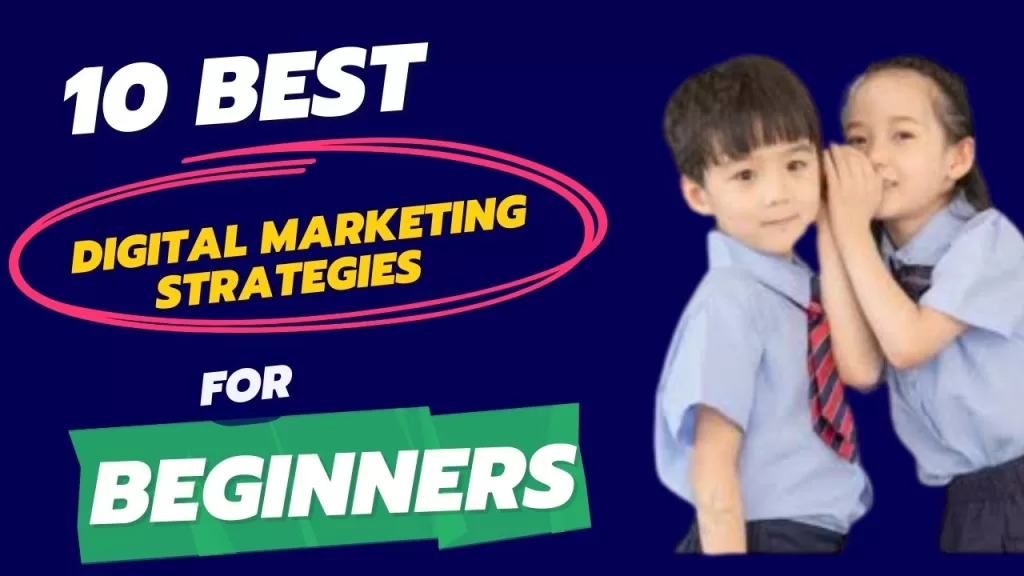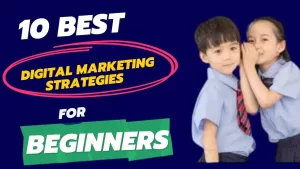Effective Digital Marketing Strategies
Effective Digital Marketing Strategies
What is Digital Marketing?
Digital marketing refers to the use of various digital channels and technologies, such as social media, email, search engines, and online advertising, to promote and advertise products or services. The goal of digital marketing is to reach and engage with potential customers online and ultimately drive conversions and sales.
1. Use social media platforms to build relationships and engage with potential and current customers.
Here are some tips on how to use social media platforms to build relationships and engage with potential and current customers:
Identify your target audience: Determine who your target audience is and which social media platforms they use the most.
Create valuable content: Share relevant, interesting, and helpful content that provides value to your target audience.
Engage with your audience: Respond to comments and messages, ask questions, and encourage discussions. This will help to build relationships with your followers.
Use social media as a customer service channel: Respond to customer inquiries and complaints in a timely and professional manner.
Leverage social media advertising: Use social media advertising to target specific audiences and drive engagement and conversions.
Monitor your social media analytics: Monitor your social media analytics to see what content performs well and what doesn’t, and adjust your strategy accordingly.
Collaborate with influencers: Partner with influencers who have a large following in your target audience to reach a wider audience and build trust with potential customers.
How to Earn 1000 Per Day Without Investment
2. Use online surveys and feedback tools to gather customer feedback and track customer trends.
Here are the steps you can follow to use online surveys and feedback tools to gather customer feedback and track customer trends:
Identify the purpose of the survey or feedback tool and the specific information you want to collect from your customers.
Choose a reliable online survey or feedback tool that fits your needs and budget.
Design your survey or feedback form, ensuring that questions are clear and concise, and that the survey is visually appealing and easy to use.
Test your survey or feedback form before launching it to ensure that it works correctly and that it provides valuable insights.
Distribute your survey or feedback form to your customer base using various channels, such as email, social media, or on your website.
Analyze the results of your survey or feedback tool and identify key trends and insights that can help you make informed decisions about your products or services.
Take action based on the insights you gather and communicate the results and any changes you make to your customers to demonstrate that you value their feedback.
Repeat the process regularly to track changes in customer feedback over time and identify new trends and insights that can help you improve your business.
3. Use online display advertising to reach a large audience.
To use online display advertising to reach a large audience, follow these steps:
Define your target audience and their interests.
Select a platform that has a large audience reach, such as Google Ads, Facebook Ads, or programmatic advertising networks.
Create compelling ad creative that grabs attention and encourages clicks.
Choose the right ad format, such as banners, videos, or native ads, that fits the platform and audience.
Set a budget and bid for ad placements.
Monitor and optimize your campaign performance based on key metrics such as impressions, clicks, and conversions.
Continuously test and refine your ad creative and targeting to improve results over time.
Effective Marketing Strategies Digital
4. Use online search engine optimization to improve website visibility and improve click-through rates.
To use online search engine optimization (SEO) to improve website visibility and click-through rates, you can:
Research relevant keywords and use them in your website’s content, titles, meta descriptions, and URLs.
Optimize your website’s loading speed and ensure it is mobile-friendly.
Create high-quality and engaging content that provides value to your audience.
Build high-quality backlinks to your website from reputable sources.
Use social media to promote your website and engage with your audience.
Regularly update your website’s content to keep it fresh and relevant.
Monitor your website’s performance using analytics tools and make adjustments based on the data.
Consider hiring a professional SEO expert to help you with your optimization efforts.
5. Use online content creation and distribution tools to create and share valuable information with customers.
Here are some steps to use online content creation and distribution tools to create and share valuable information with customers:
Determine your target audience: Understand who your target audience is and what type of content they are interested in.
Create valuable content: Use tools like Canva, Adobe Creative Suite, or other online design tools to create visual content like infographics, presentations, and images. Use writing tools like Google Docs, Microsoft Word, or Grammarly to create written content like blog posts, articles, or social media posts.
Choose the right distribution channels: Identify the channels where your audience is most active and engaged, such as social media platforms like Facebook, Twitter, or LinkedIn, or other platforms like email marketing, video marketing, or podcasts.
Optimize your content for search engines: Use keywords, meta descriptions, and alt tags to make your content easily discoverable in search engines.
Track and analyze your performance: Use tools like Google Analytics or other marketing analytics platforms to track your content’s performance and make adjustments to your strategy accordingly.
Engage with your audience: Respond to comments and feedback on your content, engage with your audience through social media, and encourage them to share your content with others.
Effective Digital Marketing Strategies
6. Use online email marketing to send targeted messages to customers.
To use online email marketing to send targeted messages to customers, follow these steps:
Build a targeted email list of customers who have opted in to receive your emails.
Create personalized, relevant, and engaging email content that resonates with your target audience.
Use email marketing tools to segment your email list based on factors such as demographics, behavior, and interests.
Use automation to send triggered emails based on specific actions, such as abandoned cart reminders or welcome series.
Track and analyze your email campaigns to measure their effectiveness and make data-driven improvements to future campaigns.
7. Use online video marketing to create engaging and informative videos that can be shared online.
Here are some tips for using online video marketing to create engaging and informative videos:
Define your target audience and goals for the video.
Keep your video short and to the point, with a clear and compelling message.
Use high-quality visuals and audio to capture and retain viewers’ attention.
Include a call to action at the end of the video, such as a link to your website or social media pages.
Optimize your video for search engines by using relevant keywords in the title, description, and tags.
Share your video on social media and other online platforms to reach a wider audience.
Monitor and analyze the performance of your video using metrics such as views, engagement, and conversions, and adjust your strategy accordingly.
8. Use online banner and pop-up advertising to reach a small audience.
Here are some tips for using online banner and pop-up advertising to reach a small audience:
Target your audience: Use audience targeting options, such as demographic and interest-based targeting, to reach the specific audience you want.
Keep it simple: Use simple and clear messaging that immediately catches the viewer’s attention.
Use eye-catching visuals: Use bright colors, bold fonts, and high-quality images to make your banner and pop-up ads visually appealing.
Use a strong call-to-action: Encourage your audience to take action with a clear and compelling call-to-action that stands out.
Test and optimize: Continuously monitor and adjust your ad campaigns to improve their performance and increase their effectiveness.
9. Use online couponing and deal advertising to drive traffic to your website.
Here are some tips to use online couponing and deal advertising to drive traffic to your website:
Partner with coupon and deal websites: Partner with websites that offer deals and coupons, such as RetailMeNot, Coupons.com, and Groupon. These sites have a large audience and can help you reach potential customers.
Create your own coupons: Create your own coupons and offer them on your website, social media, or through email marketing. This can help drive traffic to your site and increase conversions.
Advertise your deals: Advertise your deals and coupons through Google Ads or social media ads. This can help increase visibility and drive traffic to your website.
Offer exclusive deals: Offer exclusive deals to your email subscribers or social media followers. This can help build loyalty and increase engagement.
Monitor and track results: Use analytics tools to track the results of your couponing and deal advertising campaigns. This can help you understand what’s working and what’s not, and make adjustments to your strategy accordingly.
10. Use online remarketing to recapture customers who have already visited your website.
Online remarketing is a powerful tool that allows you to reach out to customers who have previously visited your website but didn’t convert. Here are some steps you can take to effectively use online remarketing to recapture those customers:
Set up a remarketing campaign: Use a remarketing platform such as Google Ads to create a remarketing campaign.
Create specific ads: Create ads that are relevant to the products or services the customer was browsing on your website. Tailor the message to their specific interests.
Set up audience targeting: Set up audience targeting so that your ads are shown to people who have visited your website but haven’t yet made a purchase.
Set up frequency capping: Limit the number of times your ad is shown to each person to avoid overwhelming them with your message.
Track and measure your results: Use analytics tools to measure the effectiveness of your remarketing campaign, and make adjustments as needed to improve your results.
By following these steps, you can use online remarketing to recapture customers who have already visited your website and increase the chances of them making a purchase.
Conclusion:
Effective digital marketing strategies for small businesses include creating a strong online presence through a website and social media platforms, utilizing search engine optimization (SEO) techniques to improve visibility in search results, developing a content marketing strategy to provide valuable information to potential customers, utilizing email marketing to nurture leads and maintain customer relationships, and using paid advertising on social media and search engines to drive traffic and sales. It’s important to track and analyze data to continually refine and improve these strategies for the best results.
Does Youtube Shorts Make Money?
Benefits of Yoga and Meditation
Meditation Benefits for Mental Health
Anti Money Laundering Act and Regulations
Effective Digital Marketing Strategies

Through my words, I Strive to evoke emotions, challenge Norms, and inspire change. Whether it’s delving into the complexities of human relationships, shedding light on social issues, or celebrating the beauty of our cultural heritage, I aim to create a lasting impact. With every word, I weave together stories that resonate with audiences, sparking conversations and fostering a sense of unity. Being a Pakistani content writer is not just a profession; it’s a responsibility to uplift and empower through the power of storytelling.


